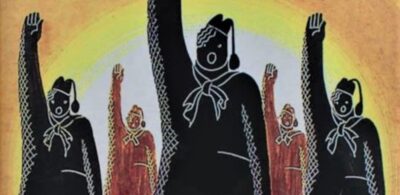Bush & the 2007 Venice Biennale
It’s more than a little interesting that the most reactionary administration in America’s history would nominate an openly Gay conceptual artist to be a symbol for the “excellence, vitality, and diversity of the arts in the United States.” The Bush State Department has chosen Felix Gonzalez-Torres to represent the U.S. at the 2007 Venice Biennale, and what a wise pick it is to choose a deceased artist – the first in 20 years according to the New York Times.
Gonzalez-Torres’ installation art had a social/political bent to it, given to expressing indignation over homophobia, U.S. foreign policy, racism, sexism, and the callous treatment of the poor and foreign born. During the first Gulf War, the Guggenheim Museum exhibited one of the artist’s installations, Untitled (Public Opinion), a 700-pound heap of black licorice candies that according to Gonzalez-Torres, represented the missiles being fired at Iraq as well as the jingoistic nationalism of the US. Goodness knows what the artist would be saying today about the U.S. occupation of Iraq, but it’s a certainty he would be vociferously and noisily opposed. Which makes the Bush State Department crowning him as the representative of American artists all the more perplexing. Just who do they think they’re fooling – you? The intended message is that this administration is fair, open-minded and embraces everyone – but its blatant homophobic and misogynist policies belie the truth.
Felix Gonzalez-Torres was born in 1957 in Cuba, grew up in Puerto Rico, and eventually moved to New York City in 1979 where he died of AIDS at 38 in 1996. In a 1995 interview by Robert Storr, Gonzalez-Torres was asked, “How do you define the political or social dimension of art?” He answered much the same as I would: “I’m glad that this question came up. I realize again how successful ideology is and how easy it was for me to fall into that trap, calling this socio-political art. All art and all cultural production is political. I’ll just give you an example. When you raise the question of political or art, people immediately jump and say, Barbara Kruger, Louise Lawler, Leon Golub, Nancy Spero, those are political artists. Then who are the non-political artists, as if that was possible at this point in history? Let’s look at abstraction, and let’s consider the most successful of those political artists, Helen Frankenthaler. Why are they the most successful political artists, even more than Kosuth, much more than Hans Haacke, much more than Nancy and Leon or Barbara Kruger? Because they don’t look political! And as we know it’s all about looking natural, it’s all about being the normative aspect of whatever segment of culture we’re dealing with, of life. That’s where someone like Frankenthaler is the most politically successful artist when it comes to the political agenda that those works entail, because she serves a very clear agenda of the Right.”
Later on in the same interview Gonzalez-Torres’ said; “… We know aesthetics are politics. They’re not even about politics, they are politics. Because when you ask who is defining aesthetics, at what particular point – what social class, what kind of background these people have – you realize quickly again that the most effective ideological construction are the ones that don’t look like it. If you say, I’m political, I’m ideological, that is not going to work, because people know where you are coming from. But if you say, “Hi! My name is Bob and this is it,” then they say, that’s not political. It’s invisible and it really works. I think certain elements of beauty used to attract the viewer are indispensable. I don’t want to make art just for people who can read Fredrick Jameson sitting upright on a Mackintosh chair. I want to make art for people who watch the Golden Girls and sit in a big, brown, Lazy-boy chair. They’re part of my public too.”
In a moment that foretold the grim future to come, the artist mentioned the following in his 1995 interview; “Here is something the State Department sent to me in 1989, asking me to submit work to the Art and Embassy Program. It has this wonderful quote from George Bernard Shaw, which says, ‘Besides torture, art is the most persuasive weapon.’ And I said I didn’t know that the State Department had given up on torture – they’re probably not giving up on torture – but they’re using both.” One can only imagine the outrage the artist would have expressed over extraordinary rendition, Abu Ghraib and Guantanamo Bay. Clearly he would have seen his being appointed representative to the 2007 Venice Biennale as a ‘persuasive weapon’ in the hands of his foes – and if he had accepted such an appointment, he no doubt would have raised a ruckus in Venice that would cause no end of embarrassment for the Bush State Department. But alas, the gentle artist is no longer here to defend himself or his art – and the buzzards will make of his legacy what they will.
Does anyone actually think Americans will be so dazzled by the choice of Gonzalez-Torres as U.S. representative to the 2007 Venice Biennale that they’ll forget all about the long list of misdeeds and transgressions committed by the Bush administration? And what about the president’s mass base, the right-wing Christian fundamentalists who swept Bush and his neocons to power – what will they think about the appointment of Gonzalez-Torres? Surely they will feel an angry sense of betrayal at having been abandoned and deceived. No my friends, the “culture wars” in America are raging stronger than ever, and the confused and desperate Bush administration has proved as inept on the home front as it has on the foreign battlefield.



